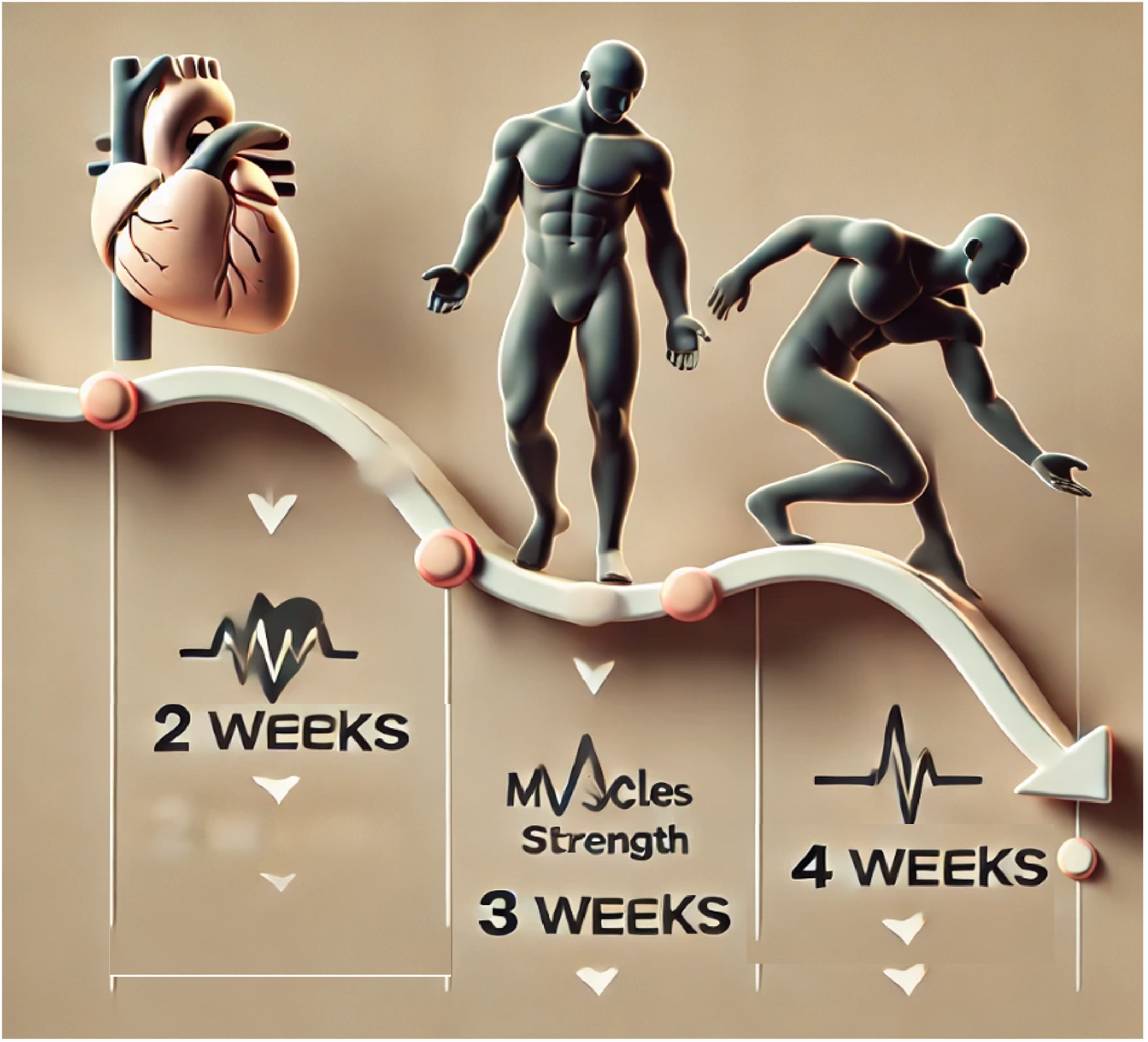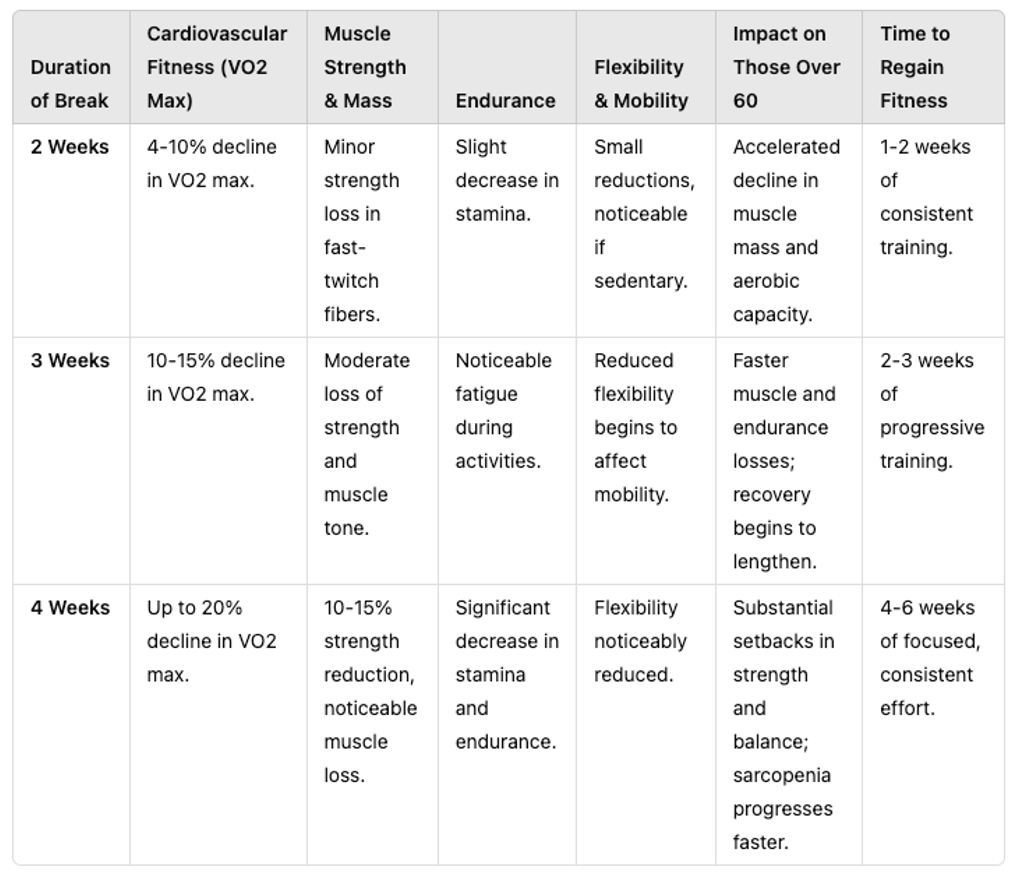The Impact of Stopping Your Exercise Routine
What Happens When You Take a Break?
Regular exercise, whether it’s hitting the gym twice a week or cycling twice a week, significantly contributes to physical fitness, cardiovascular health, and mental well-being. However, life sometimes interrupts even the most disciplined routines. Understanding the effects of a temporary pause on your fitness and what it takes to bounce back is key, especially for individuals over 60, who may face additional challenges.
Impact of a Two-Week Break
Within just two weeks of inactivity:
Cardiovascular Decline: VO2 max (a measure of your aerobic fitness) can drop by 4-10%. This means your heart and lungs become less efficient at delivering oxygen to your muscles during exercise.
Muscle Strength: Strength begins to decline slightly, particularly in fast-twitch muscle fibers, which are used in strength training and high-intensity activities.
Flexibility and Mobility: Small reductions in flexibility and joint range of motion may occur, especially if stretching isn’t maintained.
Over 60: Muscle mass and aerobic capacity decline faster due to age-related changes, making even short breaks noticeable.
Getting Back on Track: After a two-week break, it typically takes 1-2 weeks of consistent training to regain your previous fitness level.
Impact of a Three-Week Break
By the third week:
Cardiovascular Fitness: VO2 max can drop by as much as 15%. You might notice increased fatigue during activities like cycling or running.
Muscle Strength and Endurance: Muscle loss accelerates, and endurance diminishes. Activities that once felt easy may now feel challenging.
Metabolism: Your resting metabolic rate may decrease slightly, potentially leading to weight gain if caloric intake remains unchanged.
Over 60: Sarcopenia (age-related muscle loss) progresses more rapidly, and strength diminishes at a faster rate compared to younger individuals.
Getting Back on Track: Recovery might take 2-3 weeks of consistent, progressive training, depending on how active you were before the break.
Impact of a Four-Week Break
By the end of four weeks:
Cardiovascular Fitness: VO2 max can decline by up to 20%, making aerobic activities like cycling significantly harder.
Muscle Strength and Mass: Muscle loss becomes more noticeable, with reductions in strength of 10-15% in some individuals.
Mental Health: The mood-boosting effects of exercise, such as reduced stress and improved sleep, may wane, leading to higher levels of anxiety or restlessness.
Over 60: Longer breaks can result in substantial setbacks. Aging muscles lose strength and mass more quickly, and recovery may take longer.
Getting Back on Track: It could take 4-6 weeks of consistent, focused effort to regain your prior fitness level, particularly for those over 60.
Why Age Matters
For individuals over 60, the physiological impact of exercise pauses is more pronounced:
Muscle Loss: Muscle mass declines by about 3-5% per decade after 30, accelerating after 60. Regular resistance training slows this process, but breaks can undo progress faster than in younger individuals.
Bone Density: Weight-bearing exercises maintain bone density, which is critical for older adults. Pausing may increase the risk of bone weakening.
Flexibility and Balance: These are more challenging to maintain with age and can decline noticeably after even short breaks.
Impact of Exercise Breaks
Strategies to Bounce Back
Start Slow: Gradually reintroduce intensity. Begin with lighter weights and shorter aerobic sessions, then build up.
Prioritize Consistency: Commit to at least three sessions a week to rebuild strength and cardiovascular health.
Strength Training: Focus on resistance exercises to regain muscle mass and slow age-related losses.
Aerobic Conditioning: Gradually increase the duration and intensity of cycling or other cardio activities.
Stretching and Mobility: Include daily stretching or yoga to regain flexibility and reduce stiffness.
Rest and Nutrition: Recovery is vital, especially for older adults. Ensure adequate protein intake to support muscle repair and prioritize sleep.
Conclusion
Taking a break from exercise can lead to noticeable declines in fitness, especially for older adults. While the human body is resilient and you can regain your fitness with consistency and a structured approach, there is always a "price" to pay for stopping. The longer you wait to return to your training, the higher that price becomes, both in effort and time needed to recover.
So, before stopping and not returning to your routine, think carefully about the impact. It is wiser to continue—even if at a reduced intensity—unless you are injured or have a compelling reason to pause. Staying active is always the better choice for maintaining long-term health and performance. Remember, the key is to listen to your body, stay patient, and remain committed to your health journey.


